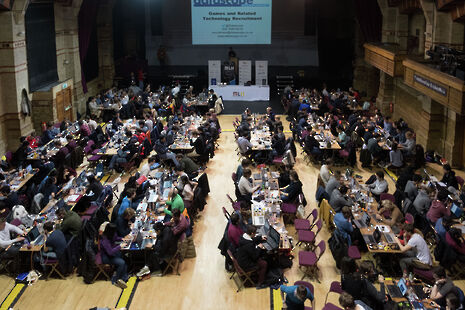Cracking the code of gender disparity at the Cambridge hackathon
The Hack Cambridge organisers sought to increase non-male representation through positive action programmes

Last weekend, over 300 students gathered at the Corn Exchange to participate in the third annual Hack Cambridge, a 24-hour-long competition designed to urge teams to develop innovative technological projects, and the first year that special efforts were made on the organisers’ part to encourage female hackers to take part.
In Cambridge, women made up just 13.6% of undergraduates studying for the Computer Science Tripos for the academic year 2016-17, making them an underrepresented group. Despite yearly variations, with the proportion of female students in the subject falling below 10% in some years, little progress appears to have been made in attracting young women — the proportion of female students sixteen years ago, for example, was at a similar level of 13.3%.
This gender imbalance is often very visible at hackathons. Peter Scharrer, Communications Manager for Hack Cambridge, told Varsity, “This year we’ve worked really hard to try and minimise the gender disparity.”
In the lead-up to the event, Hack Cambridge worked with several female and non-binary organisations, including Women@CL, a positive action programme for women in computing research, and the Cambridge University Women in Business Society (CAMWIB), “to make sure the recruitment process reached as many talented female students as possible.” They also organised a dinner with one of the event sponsors, Improbable, solely for female and non-binary students.
Scharrer added, “Mainly our outreach efforts have been attempting to make clear that hackathons, and computer science, are for everyone and certainly not something that so many brilliant young women should feel turned away from.”
According to statistics from Hack Cambridge organisers, 67 of 322 participants (20.8%) identified as a gender other than male. Although a wide variety of subjects were represented at the hackathon, including Law and Linguistics, the vast majority of students were undertaking technology or engineering based degrees, with almost 50% studying pure Computer Science.
The atmosphere at the hackathon was of enthusiasm, with hackers eager to see and learn from the various projects on display around the room, as well as to share their own creations and insights.
A huge range of projects were undertaken, with some aiming to tackle important issues in society — such as seizure identification — and others to create enjoyable, often humorous, programmes.
During the twenty-four hours, one team of hackers created ‘Bad Flamingo’, a high-tech version of Pictionary in which players attempt to draw objects sufficiently ‘badly’ or uniquely that the computer is unable to recognise them, but not so strangely that their partner is unable to identify the image. The creators of ‘Bad Flamingo’ took home the Hack Cambridge trophy, after their game was judged to be the “most innovative, technically challenging and well-designed project.”
Only one team consisted entirely of women. They designed ‘Pantry Log,’ an app to monitor food purchases and expiry dates in order to minimise waste, for which they won second place. Team members Silvia Sapora, Elena Liu and Ami Zou said the project was inspired by “a combination of love for food and tech addiction.”
Meanwhile, others chose to focus on developing medical technology, including programs to aid the visually impaired and those suffering from fits or seizures. Speaking to Varsity, one participant, Alex Thorne, said that his goal was to “use computers to provide much-needed assistance to those struggling with mental health issues,” noting specifically that technology can help us to “understand ourselves better.”
Many teams, even those who created games, considered practical uses. The creators of ‘Mission Hack’, a “modern treasure hunt” with the goal of “game-ifying the environment,” suggested that possible applications of their project include education as well as health and safety training.
Scharrer described the hackathon as “a collaborative programming experience that brings together talented students and allows young computer scientists, engineers, and designers to hone their skills in a social and enjoyable environment.
“Every year we try to work with some really inspiring companies to provide our hackers with a huge range of hardware and software with which they can produce their projects.”
Although most were rather sleep-deprived by the end of the hackathon, several participants described the experience as “enjoyable and valuable,” and many seemed keen to participate again in future
 Comment / Plastic pubs: the problem with Cambridge alehouses 5 January 2026
Comment / Plastic pubs: the problem with Cambridge alehouses 5 January 2026 News / Cambridge academics stand out in King’s 2026 Honours List2 January 2026
News / Cambridge academics stand out in King’s 2026 Honours List2 January 2026 News / Cambridge businesses concerned infrastructure delays will hurt growth5 January 2026
News / Cambridge businesses concerned infrastructure delays will hurt growth5 January 2026 News / AstraZeneca sues for £32 million over faulty construction at Cambridge Campus31 December 2025
News / AstraZeneca sues for £32 million over faulty construction at Cambridge Campus31 December 2025 Interviews / You don’t need to peak at Cambridge, says Robin Harding31 December 2025
Interviews / You don’t need to peak at Cambridge, says Robin Harding31 December 2025










